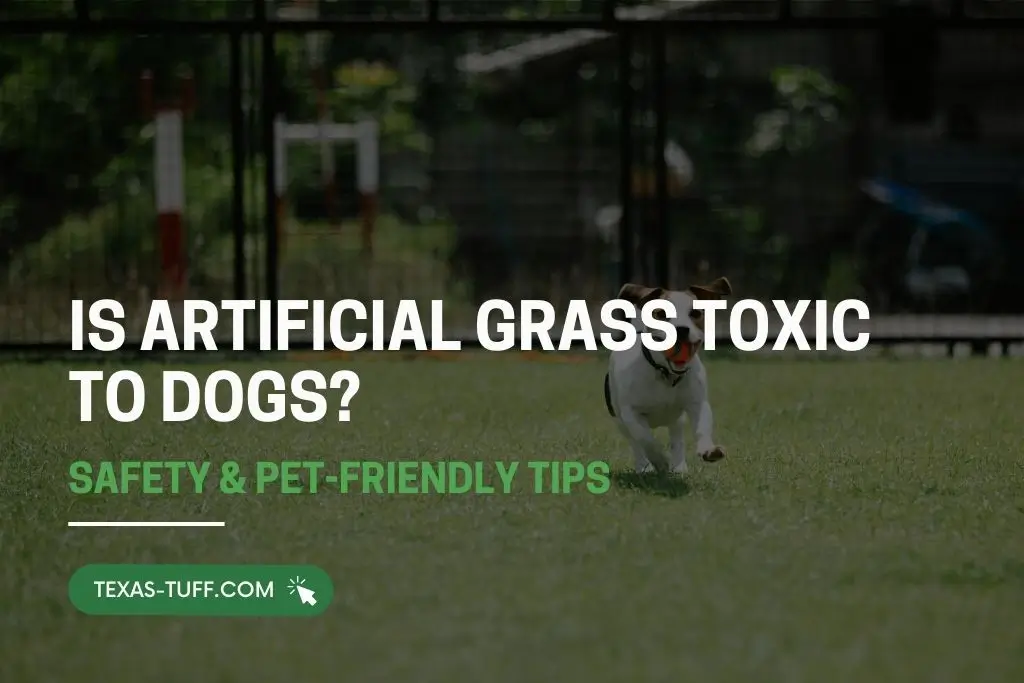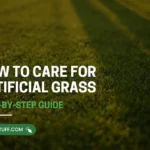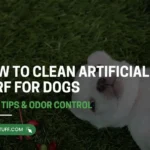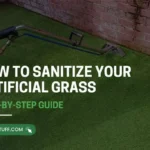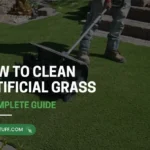Did you know that more than 66% of U.S. households own a pet, with dogs being the most popular? For dog owners, keeping a safe and healthy backyard is just as important as maintaining a beautiful lawn.
Artificial grass has become a popular choice for homeowners who want a green, low-maintenance lawn year-round. But if you have a dog, you might be wondering:
- Is artificial grass safe for dogs?
- Could it be toxic?
Dogs interact with their outdoor spaces constantly, whether they’re digging holes, chasing toys, or enjoying a sun-soaked nap. That’s why understanding whether synthetic turf is safe is crucial for both your peace of mind and your dog’s health.
In this guide, we’ll cover:
- The safety of artificial grass for dogs
- Materials used in modern turf
- How to choose pet-friendly options for your backyard
With this information, you’ll know how to create a safe, enjoyable outdoor space for your furry friends.
Why Cleaning Artificial Turf for Dogs Is Important
The short answer: yes, most modern artificial grass is safe for dogs. Today’s synthetic lawns are made from non-toxic materials designed to mimic real grass while being durable, heat-resistant, and pet-friendly.
However, not all artificial turf is created equal. Some cheaper products may contain:
- Heavy metals
- Harmful chemicals
- Low-quality plastics
These can pose risks if your dog chews, licks, or spends a lot of time on the lawn.
Most high-quality artificial grasses are made from polyethylene or polypropylene fibers and often use rubber or sand infill.
These materials are:
- Generally considered safe for pets
- Non-toxic
- Resistant to bacterial growth when cleaned properly
Pet owners love artificial grass because it offers several advantages:
Easy to clean – Pet waste can be hosed off, and solid waste scooped without worrying about killing the grass.
Durable – Dogs can run, dig, and play freely; synthetic grass handles high traffic better than natural lawns.
Chemical-free – No pesticides or fertilizers are needed, keeping pets safe from harmful substances.
Even though artificial turf is safe, it is important to:
- Choose pet-specific products.
- Look for certifications.
- Ensure proper installation and maintenance.
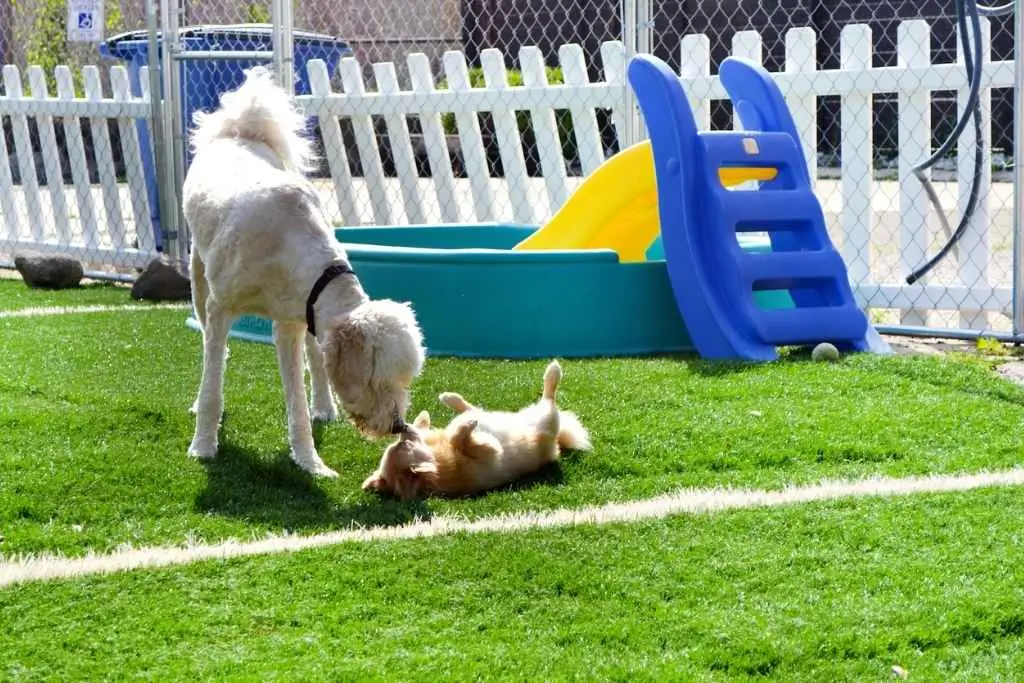
Potential Risks of Artificial Grass for Dogs
While modern artificial grass is generally safe, there are a few potential risks that dog owners should be aware of:
1. Heat Retention
Artificial turf can get much hotter than natural grass, especially in full sun. On a hot summer day, the surface temperature of synthetic grass can exceed 120°F (49°C), which is hot enough to burn your dog’s paws.
Tip:
- Provide shaded areas for your dog to rest
- Lightly water the turf to cool it down before playtime
2. Chewing and Ingestion
Some dogs, especially puppies, may chew on the turf. While high-quality artificial grass is non-toxic, ingesting pieces of turf or infill material can cause:
- Digestive upset
- Potential blockages
Tip:
- Train your dog to avoid chewing the lawn
- Remove any loose pieces immediately
3. Surface Hardness
Artificial turf does not have soil underneath like natural grass, which can make it firmer and less forgiving on joints. Dogs with arthritis or older dogs may find prolonged play on turf uncomfortable.
Tip:
- Add a soft base layer or padding beneath the turf in areas where your dog plays frequently
4. Bacterial Growth if Not Cleaned
Pet waste left on the turf can lead to bacteria buildup. Unlike natural grass, which can absorb some waste, artificial turf needs regular cleaning and disinfecting to prevent odors and keep your dog healthy.
Tip:
- Use a pet-friendly turf cleaner
- Rinse the area with water after your dog goes to the bathroom
With the right care, maintenance, and product selection, these risks are mostly preventable. When installed and maintained properly, artificial grass can be a safe and convenient lawn solution for dog owners.
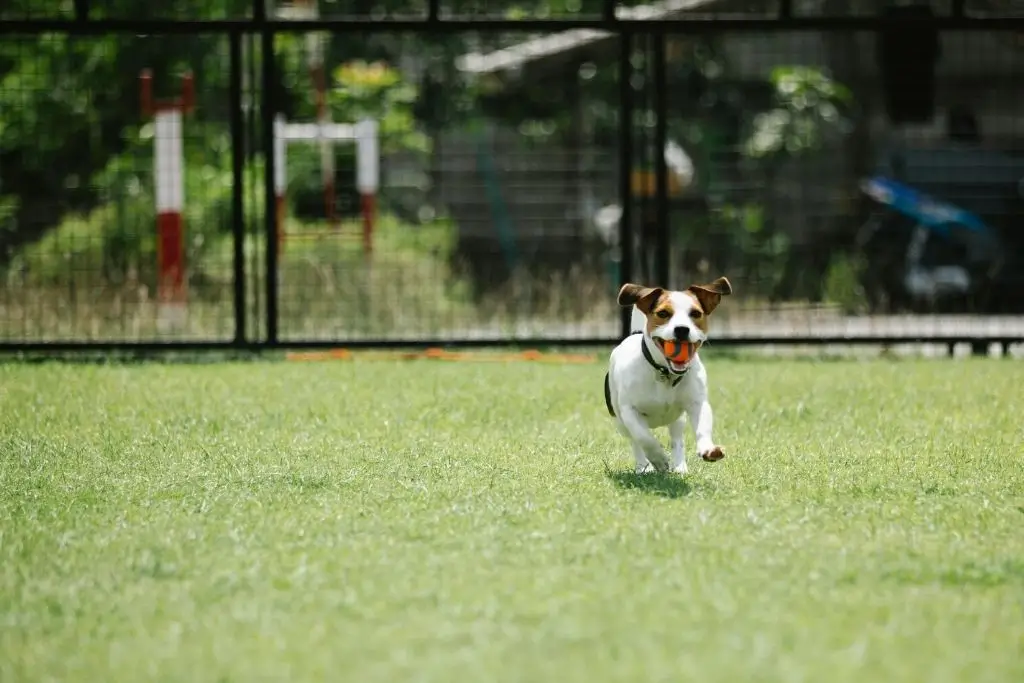
How to Choose Pet-Safe Artificial Grass
Not all artificial grass is created equal, so choosing the right product is key to keeping your dog safe and happy. Here’s what to look for when shopping for pet-friendly turf:
1. Non-Toxic Materials
Choose artificial grass made from non-toxic polyethylene or polypropylene fibers and avoid products that contain heavy metals, lead, or other harmful chemicals that your dog might ingest or lick.
2. Low or No Infill
Many artificial lawns use infill materials like crumb rubber or sand for stability. For dogs, choose turf with pet-safe or low-infill designs to reduce ingestion risks. Some pet-specific turfs are even designed to work without infill entirely.
3. Drainage System
A good pet-friendly turf must have excellent drainage to prevent odors, standing water, and bacteria growth. Check for perforated backing or specialized drainage layers to keep the turf clean and dry.
4. Durable Construction
Active dogs need turf that can withstand running, digging, and play. Look for high-density fibers and reinforced stitching to prevent wear and tear over time.
5. Easy to Clean
Pet-friendly artificial grass should be simple to rinse and disinfect. Many turfs are compatible with:
- Hose-down cleaning
- Enzymatic sprays
- Power washing without damage
6. UV-Resistant
If your backyard gets a lot of sun, choose turf with UV protection to prevent fading and overheating. This keeps your dog safer on hot days.
Tips for Maintaining Artificial Grass With Dogs
Even the safest, most durable artificial grass requires proper care to keep it hygienic and long-lasting, especially if your dog spends a lot of time outdoors. Here are some practical tips:
Clean Up Solid Waste Quickly
Pick up solid waste promptly to prevent odors and bacterial buildup. Dispose of it in your regular trash or compost if appropriate.
Rinse Regularly
Rinse areas where your dog urinates with a hose to flush out urine and prevent lingering smells. For heavily used spots, consider using a pet-safe turf deodorizer.
Use Enzymatic Cleaners
Enzymatic cleaners break down organic matter, keeping the lawn free from bacteria and odors. They are especially helpful in high-traffic areas your dog uses frequently.
Brush the Grass
Regular brushing keeps the fibers upright and prevents matting. It also spreads infill evenly if your turf has sand or rubber fillers.
Check for Damage
Inspect your turf periodically for loose fibers, worn spots, or chewing damage. Prompt repairs help prevent ingestion hazards and extend the life of your lawn.
Provide Shade and Cooling
Artificial grass can get hot under the sun. Offer shaded areas, cooling mats, or occasionally spray water on the turf to keep your dog comfortable during playtime.
Creating a Safe, Green Haven for Your Dog
Artificial grass can be a safe, practical, and attractive solution for dog owners who want a low-maintenance backyard without compromising their pet’s health.
Maintaining proper cleaning routines and providing shaded or cooled areas helps you enjoy a lush, green lawn year-round that stands up to playful pups.
Artificial grass also reduces the need for watering, mowing, and chemical treatments, keeping your dogs safe from harmful pesticides and fertilizers.
With the right installation and care, you can create a durable, hygienic, and visually appealing outdoor space that both you and your furry friends will love.
If you’re thinking about making the switch, look for certified, pet-safe products. Follow the maintenance tips outlined in this guide to ensure your dog’s lawn stays healthy, safe, and enjoyable for years to come.
FAQs About Artificial Grass and Dogs
Artificial turf can get hot in direct sunlight. Provide shaded areas, water the turf occasionally, or use cooling mats to protect your dog’s paws and prevent overheating.
Artificial grass is less hospitable to fleas and ticks than natural lawns, but it is not a complete solution. Regular flea and tick prevention for your dog is still recommended.
While artificial grass discourages digging, determined dogs may still try. Installing a proper base layer and supervising playtime can help minimize digging behavior.

